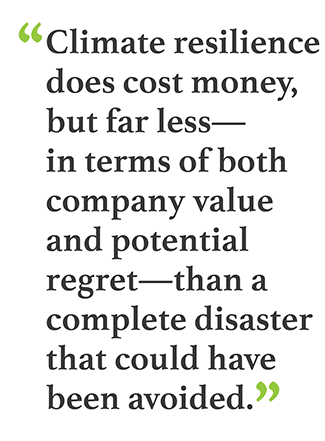
As we continue to adapt to the unpredictable business impacts of the coronavirus pandemic, corporate finance managers should also make time to think about the longer-term future. Certainly, most finance teams face pressing concerns around liquidity, debt management, and possibly their supply chain. But other, more enduring risks are still waiting in the wings to inflict financial harm over the coming decades.
Like climate risk.
Recommended For You
Climate risk shares a number of characteristics with a pandemic. One is that corporate finance and risk executives have little control over either. Another is that both types of risk can be complicated, unpredictable, and insidious—and can result in long-term business disruption and associated cash-flow constraints.
However, unlike a pandemic, the effects of climate risk are foreseeable. Finance and risk management teams can fairly accurately predict in advance the physical and financial implications of climate change on specific properties and operations. Thus, this is one of those addressable risks for which shareholders expect finance and risk managers to identify vulnerabilities and take action now to prevent future losses.
Where to Start
One key challenge for managers taking their first steps in this process is that climate-risk management can seem monolithic. Too many corporate leaders think that because climate change is out of their control, climate-risk management is an oxymoron. Some make an intentional decision to gamble that preventable disruption won't happen on their watch. Others are focused almost exclusively on the financials, not realizing that cash flow, revenue, and profit are largely a function of long-term resilience.
Any of these mind-sets can make it hard to know where to start with risk management. Fortunately, there is a straightforward process for understanding, assessing, and mitigating the company's areas of vulnerability.
The first step is to understand climate risk as a multitude of discrete natural hazard sub-risks. With hurricane and wildfire seasons under way, and flood risk ever-present, finance and risk managers must be mindful that each sub-risk may have its own potential loss expectancy that the company may be able to substantially mitigate.
The second step is to identify the different classes of climate risk. In this article, we'll focus on the risks of climate-driven natural hazards to a company's property—and, by extension, to its business continuity and value. However, many businesses face other climate-related risks, such as the strategic risks that emerge when a company relies too heavily on fossil fuels to sustain its business model.
 As a company begins its climate-risk analysis, we recommend sorting vulnerabilities into two buckets. First are the direct risks, the natural manifestations of a changing climate. These include impacts on the business of the likely worsening of flood, wind, drought, or wildland fire in the future. The other risks, indirect risks, can take the form of financial upheaval as climate-related business disruptions unfold around the world. Think crop failures, water conflicts, or new flooding of previously dry manufacturing hubs.
As a company begins its climate-risk analysis, we recommend sorting vulnerabilities into two buckets. First are the direct risks, the natural manifestations of a changing climate. These include impacts on the business of the likely worsening of flood, wind, drought, or wildland fire in the future. The other risks, indirect risks, can take the form of financial upheaval as climate-related business disruptions unfold around the world. Think crop failures, water conflicts, or new flooding of previously dry manufacturing hubs.
To an extent, business insurance addresses both aspects of climate risk, covering lost property and short-term revenue resulting from business disruption. However, insurance will not and cannot make a company whole for the total loss in value it may incur in a business-disruption event, if frustrated customers flock to competitors, fearful investors recoil, and opportunities for growth are lost forever. Nor will insurance compensate a business for the victories its more resilient competitors enjoy in terms of revenue, shareholder value, and brand enhancement.
So, the goal of the finance and risk team should extend beyond obtaining good insurance. The finance group should help lead the effort to avoid preventable losses and business disruption, and to rebound as quickly as possible when disruption is inevitable. Business continuity is a key consideration in these conversations. Real estate decisions and capital investment in physical properties should be influenced by the organization's climate-related resilience objectives.
Resilience is critical: It enables a company to keep the promises it's made to customers, employees, and investors, and to make its business plan a reality. To choose resilience in the face of climate risk, a climate-risk project team needs to take three steps:
1. Assess the risk. To properly address climate risk, an organization needs to understand the physical risks it faces. For every property, the project team needs to game out the likelihood of every climate-driven hazard that could possibly befall it, including flood, wind, drought, and wildland fire. This shouldn't be a back-of-the-napkin exercise, but should use the best available risk management experts, preferably engineers.
For example, to assess flood risk, these experts need to be looking at flood maps and considering a range of flooding scenarios, such as:
- What if we get three inches of water?
- What if we get a foot?
- What if the water seeps in over the course of a week?
- What if it happens in 10 minutes?
Every site will have different physical assets at different elevations, all of which will go into the calculations of loss likelihood and severity. What would be damaged, and how badly? What would be destroyed? Employ a similar risk assessment process for every hazard and every site at which a disaster would affect the business; the analysis should include suppliers' facilities.
2. Quantify the potential losses. Once the organization understands which facilities face which risks—and those risks' likelihood and severity—it's time to transform every potential loss into numbers. How would the loss and associated disruption affect the overall business?
Suppose a flood strikes a corporate campus with five buildings and destroys one of them. The loss in business value will depend substantially on whether that one building is a manufacturing plant, warehouse, or data center. The equipment matters, too. Did the company lose a bottling line, an MRI machine, or a turbine? Some machines and systems can be replaced more quickly than others.
The project team should calculate a loss expectancy in dollars and cents for each potential event. For best results, continue working with experienced engineers, asking them to detail potential physical-damage loss estimates, process impact, and repair requirements based on possible scenarios that account for your facilities' level of risk quality.
3. Mitigate the vulnerabilities that could hurt the business the most. At this point, the climate-risk project team should understand all the likely loss scenarios at all the company's locations. Now they need to prioritize these vulnerabilities by calculating the importance of each location to the business's long-term success.
A smart approach is to gauge the relative contribution of each location to corporate profitability. This analysis is important because it's tempting to say the most expensive buildings are the ones that need priority protection, but that may not be the case. I encountered a global manufacturer once whose smallest, least impressive location produced a seemingly minor part for a product. The location sustained a disaster that knocked it offline. No one else made the part, and the rebuilding and recertification processes took months. Being unable to manufacture its product for so long nearly put the company out of business. The disruption was a financial catastrophe that no one saw coming.
An organization that knows its physical risks and exactly how they threaten its success can look at the costs of shoring up vulnerabilities and how such investments will affect the business. Start by looking for the biggest bang for your risk management buck.
How to Invest in Climate Resilience
Investments in building long-term business resilience through climate-risk mitigation can take any of three forms. They can entail retrofitting existing properties with improvements like stronger roofs, perimeter flood barriers, or automatic fire sprinklers. Alternatively, they can involve incorporating resilient design when building out new facilities. Architects should take into consideration not only today's climate risk, but also the potentially warmer, wetter, and wilder world a given property may inhabit in 50 years. A resilient company is built to last.
The final category of business resilience investments prepares a company for emergency response and business continuity. One of the most important areas of preventative planning is plant shutdowns. Ill-prepared companies often wait too long to close operations in a disaster. They have no decision tree, and it's easier for local staff to keep producing (and making money) than to shut everything off. However, if workers let floodwaters drench electrically charged machines full of raw material, the facility might suffer an extraordinary amount of preventable loss.
There's one more thing finance and risk teams can do to prepare their business for climate-related change. They can attempt to protect their financial statements from indirect climate risks, such as turbulent markets and potential liquidity crises that may result from climate conditions in specific regions or industries. These indirect risks may be out of the company's control, but they should impact site selection. Corporate leaders can choose to do business in regions where business conditions are more resilient. When selecting a new location for any type of corporate facility, look for regions, countries, and territories with strong building codes, attentive code enforcement, political stability, and underlying economic resilience.
See also:
- Why Be Vulnerable?
- Emerging Risks: Get Ahead of the Unexpected
- A Risk by Any Other Name…
- Effects of Climate Change on Corporate Credit Ratings
By taking these steps, an organization can deliberatively improve resilience in the face of enormous global climate risk. That means finance leaders have a big role to play in how climate risk affects their business. Employees are counting on the treasury, finance, and risk management functions, and shareholders are ready to hold managers accountable.
Although climate risk is probably not at the top of the corporate agenda today, beware of letting it slide. Regardless of which other risks are dominating the headlines, climate risk remains omnipresent, and resilience is within the control of the corporate leadership team. Climate resilience does cost money, but far less—in terms of both company value and potential regret—than a complete disaster that could have been avoided.
 Denise Hebert is vice president and treasurer at FM Global, one of the world's largest commercial property insurers.
Denise Hebert is vice president and treasurer at FM Global, one of the world's largest commercial property insurers.
© Touchpoint Markets, All Rights Reserved. Request academic re-use from www.copyright.com. All other uses, submit a request to [email protected]. For more inforrmation visit Asset & Logo Licensing.



